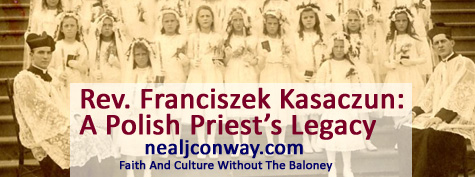 |
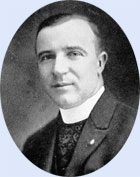 |
|---|
Rev. Franciszek Kasaczun: a Polish Priest's Legacy
April 1, 2011 (Revised April 26, 2014)
| Page 1 | Page 2 | Page 3 | Page 4 |
|---|
In 1926 came shocking news reports of machine-gun-firing bootleggers warring in the streets of Chicago. As the nation's prohibition of the manufacture, transport and sale of intoxicating liquors passed its sixth anniversary, more Americans were leaning "Wet." They were questioning the prudence and effectiveness of the liquor ban, wondering if the laws enacted to improve public morality were not, in fact, causing its deterioration.
For the moment, the "Dries" who had waged a decades-long battle to ban liquor were in control. Nevertheless, to show the public that the U.S. Congress was caring and listening, the Senate Judiciary Committee held two weeks of hearings in April of 1926 in which both "Wets" and "Dries" appeared before the panel testifying for or against repealing or modifying the Eighteenth Amendment and The Volstead Act. Only a couple members of the committee actually made themselves present to listen to the pro and con arguments.
"Wet" supporter Samuel H. Church of The Carnegie Institute accused Methodist and Baptist "reform-fanatics" of striving for "ecclesiastical mastery of private conduct, not through the Gospel but through law."(1)
Also speaking in support of the "Wets" was Rev. Franciszek Kasaczun, pastor of a Polish Catholic parish, Holy Family, in Sugar Notch, Pennsylvania. In accounts described as "lurid" and "horrifying" by Time Magazine (1), Father Kasaczun spoke of one in five households in Sugar Notch amateurishly distilling liquor that might as well have been poison. He witnessed to rampant alchoholism extending even to young children, to families breaking up, to "young girls demanding that their boyfriends provide liquor on auto parties." As far as the Polish-born priest was concerned, Prohibition was not working.
It was perhaps the only time that the little Northeastern Pennsylvania anthracite mining town ever made national news. The interesting Father Kasaczun, pastor, scholar, Polish and American patriot, was at the time one of its leading citizens.
I first heard of him from one of his former parishioners, my grandmother. Her name, Bertha Bradshaw, belied the fact that she was born Boleslawa Tombak near Sejny, a town close to the present-day Polish-Lithuanian border. The Tombaks could just as well be a Lithuanian family, but my grandmothers' people identified themselves as Poles. Boleslawa--"Bolcia" for short--is a feminization of the name of the first king of Poland, Boleslaw. He was the son of Mieszko the pagan-born Duke of the Polans who was baptized Roman Catholic in 966.
In 1904, Boleslawa's birth year, "Poland" was a dream, a poem, a play forbidden to be performed. Sejny was under the rule of Russia. The rest of the old kingdom--what had become in the minds of Poles a legend--was in German and Austrian hands. The partitioners tried to obliterate Polish culture. St. Petersburg's efforts were not as aggressive as those of Bismarck's protestant Prussians; however having a picture of Czar Nicholas II hanging prominently in the house was de rigeur.
Franciszek Kasaczun was also born near Sejny. Polish families such as his and the Tombaks left to seek a better life in the coal fields of Northeastern Pennsylvania. Immigrants tended to settle where their relatives and neighbors had preceded them. I suspect that many of the Poles who migrated to the towns south of Wilkes-Barre and joined the parish of Najswietszej Rodziny (Holy Family) came from the Sejny regon.
After growing up, Kasaczun returned to Europe to study for the priesthood with the Holy Family Fathers in France and in Terrecina, Italy where he was ordained. He became pastor of Sugar Notch's "Polish" church in 1911, right during the heyday of what were then called "national"--what we would call "ethnic"-- parishes. Continue to Page 2.
| Page 1 | Page 2 | Page 3 | Page 4 |
|---|
(1) Time Magazine, April 26, 1926, Prohibition: Committee Hearings
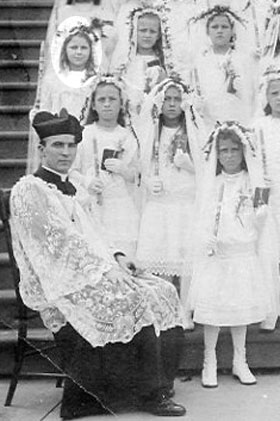 |
|---|
| Above: Fr. Kasaczun and my grandmother (highlighted in oval) are in this photo of the 1916 First Holy Communion Class at Holy Family Church (Najswietszej Rodziny) in Sugar Notch, Pennsylvania.
"Nana" was twelve years old. It was customary then to hold off initiating children into receipt of The Blessed Sacrament until they were on the verge of adolescence. However, in 1910, Pope St. Pius X, "the pope of frequent Holy Communion" decreed that the sacrament should be given to children at around the age of seven and started the process of making that practice universal in the church. The propagation took many years and probably encountered resistance in places, including the Diocese of Scranton under Bishop Michael J. Hoban. As late as 1924, Holy Family's communion classes still consisted of twelve-year-olds. Below: From Fr. Kasaczun's extensive 1928 book ranging in subjects from his parish to Polish literature: a photo of Holy Family kids dressed as Polish kings, queens and saints. The fellow in blackface with the pointy hat may well be Mieszko. Certainly one of the young ladies is Queen Jadwiga. The occasion of this masquerading could be something that the pastor arranged to teach his parishioners about their their Polish heritage or it could simply be Hallowe'en. Under Kasazcun, Holy Family fielded floats about Polish history in local parades and hosted huge gatherings at its mountainside campus. |
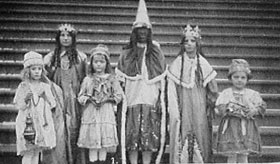 |
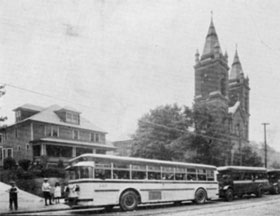 |
Holy Family's church and rectory and they appeared in the 1920s. Except for "omnibusami" arrayed to take parishioners on some kind of excursion, not much in this photo has changed. |
Copyright 2011, 2014 by Neal J. Conway. All rights reserved.
About this site and Neal J. Conway
Make homepage nealjconway.com appear in this window